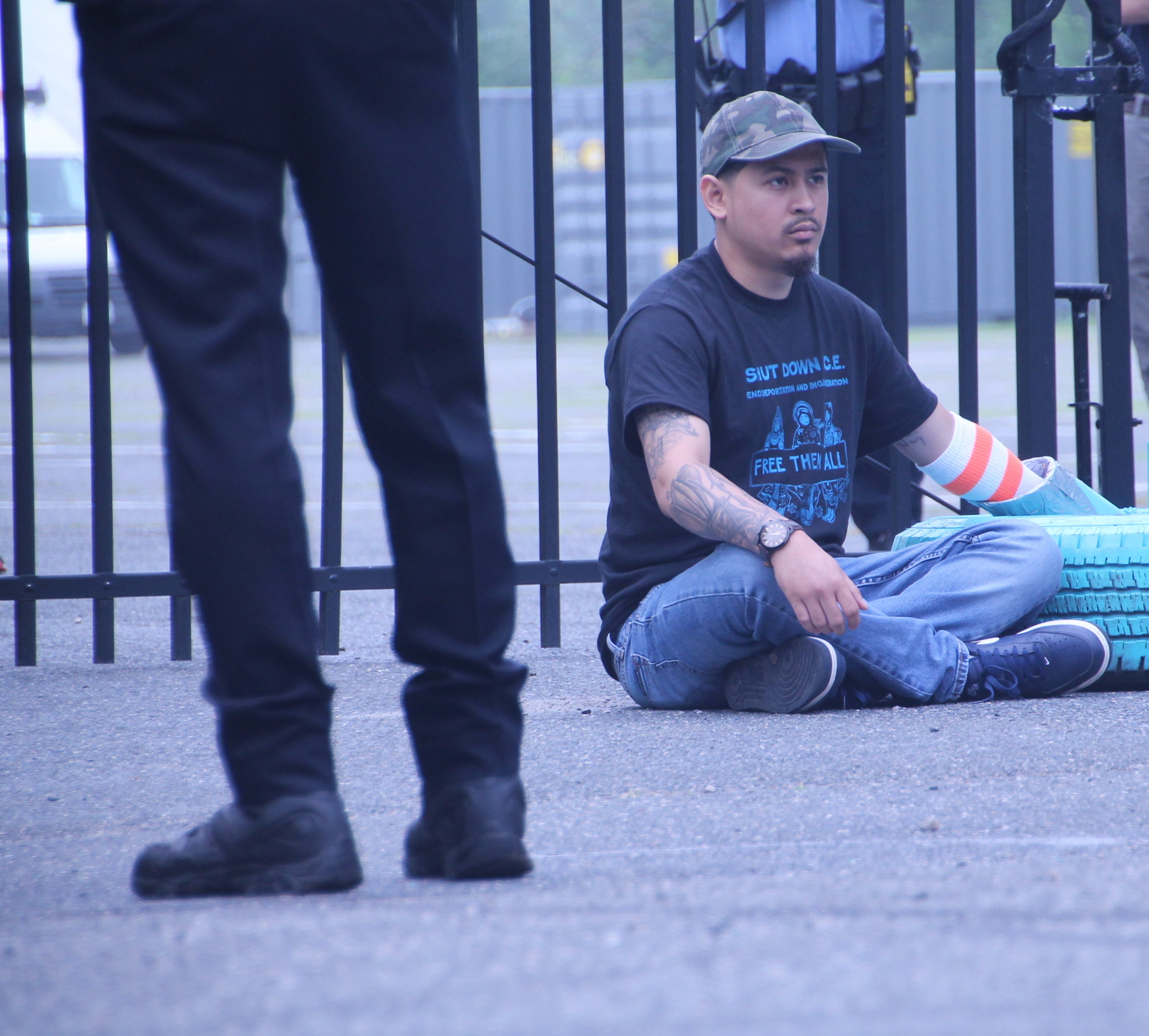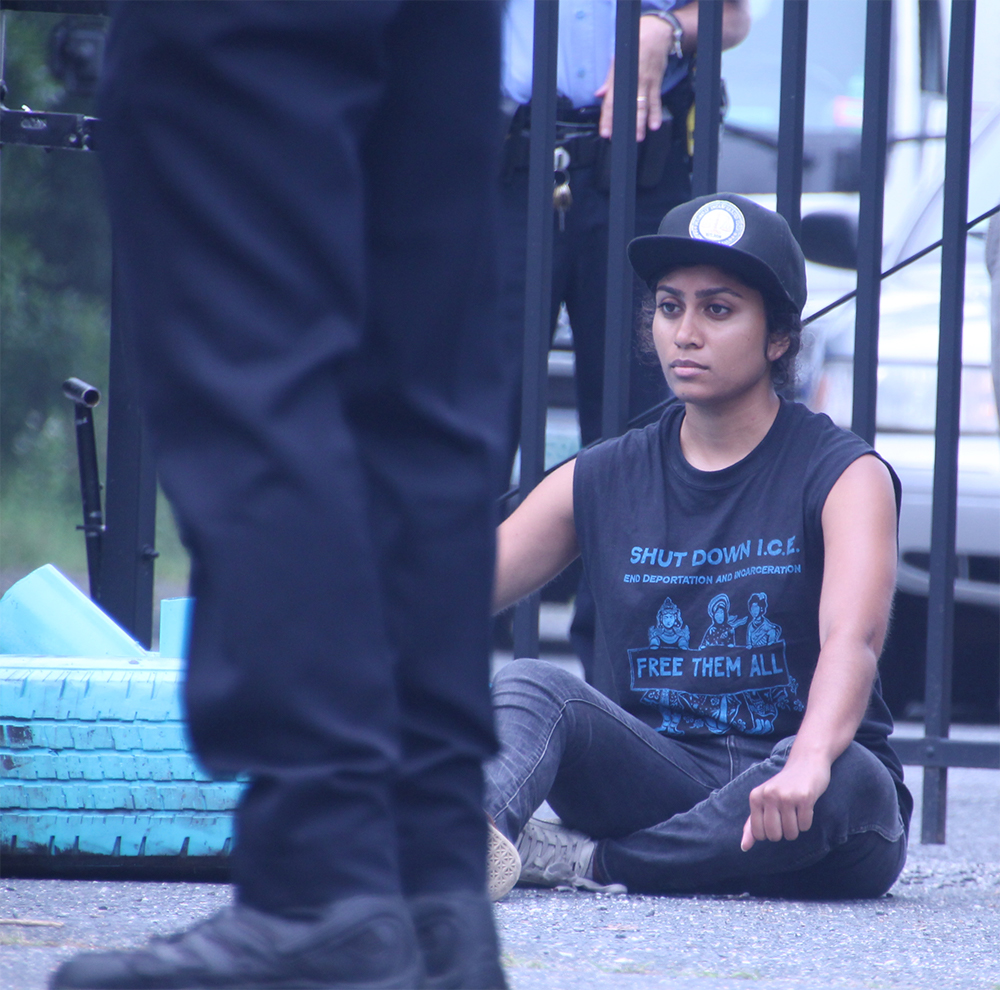
Photos by Karen Savage
Steven Dy and Anusha Alles block the entrance to the Massachusetts Department of Corrections headquarters in Milford, Mass. to protest the department’s 287(g) agreement with U.S. Immigration and Custom Enforcement.
Sitting cross-legged on the pavement, his right arm locked into a bright blue painted tire weighed down by cement and blocking the entrance to the Massachusetts Department of Corrections headquarters in Milford, Mass., 25-year-old Steven Dy appeared unfazed.
Dozens of officers from the Department of Corrections (DOC), the Milford Police Department and the Massachusetts State Police were looming over him and Anusha Alles, 29, who had locked herself into a separate tire and cement device.
The pair was engaged in a nonviolent direct action June 27 to call for an end to 287(g) agreements, which allow local law enforcement — including the Massachusetts DOC — to operate as U.S. Immigration and Custom Enforcement (ICE) officers in certain situations.
Dy’s mind was on his grandmother.
She escaped Cambodia during the 1970s, fleeing her homeland with her three daughters after her sons — Dy’s uncles — were brutally murdered by the Khmer Rouge during the genocide that was part of the regime’s attempt to isolate and control the country. In the chaos of the escape, she lost contact with her husband, Dy’s grandfather. Decades later, she would learn he’d been sent to France, where he eventually lost hope of reunification, remarried and started a new family.

Steven Dy sees the protest as an extension of the social justice work he began as a teenager.
“I did this because my family was originally separated,” said Dy, referring to the protest, which stopped all traffic in and out of the facility for nearly three hours.
“There are tons of blood relatives that I’ve never met, either because we no longer have connections or that they perished in the war,” he said. “Nobody deserves that kind of separation.”
Dy was referring to President Donald Trump’s harsh immigration policies that have separated countless families and contributed to the death of at least six children.
“I’m one of the lucky to have my immediate family still with me,” Dy said. “I cannot imagine how it feels to be separated from my mother, from my father, from my brothers and sisters, with no consolation, no empathy or sympathy — that breaks a person down and I would never wish that on anyone.”
Arrests, deportations both up
The protest was part of a week of action organized by the FANG Collective, a Rhode Island-based community organizing and direct action group, whose members are calling for an end to 287(g) agreements.

“I think a lot of people feel powerless and don’t know what to do, so I hope that people will see that and will step up,” Anusha Alles said.
The FANG Collective, along with AMOR, an alliance of several organizations in the Providence area, has been working since October 2018 to raise public awareness of the little-known collaboration between local law enforcement and ICE. The week of action came just before 287 (g) agreements expired on June 30.
“We want the Massachusetts DOC to end its collaboration and to stop aiding ICE in that way,” said Alles, who was eventually arrested by the Massachusetts State Police for trespassing, resisting arrest and disorderly conduct. “We want all the 287(g) agreements to end.”
Rhode Island is part of ICE’s Boston field office, which also covers Connecticut, Maine, Massachusetts, New Hampshire and Vermont. The office arrested 2,908 individuals in 2018, up slightly from 2,834 in 2017. The number deported rose more sharply, from 1,942 in 2017 to more than 2,405 in 2018.
It’s unclear how many of the detentions and deportations stemmed from agreements with local law enforcement. As of May 2019, ICE had 287(g) agreements with 90 law enforcement agencies in 21 states.
“We see these programs as a terrorization tactic, where if the sheriff has a 287(g), they’re immediately allowed to look into a person’s background to see if they can be detained for ICE,” said Arely Diaz, a 23-year-old organizer with the FANG Collective.
ICE did not respond to a request for comment.
How the collaborations work
It is not yet known how many communities have renewed their agreements, but most are expected to continue. The Massachusetts DOC’s 287(g) agreement with ICE has been extended through 2020 with no changes.
Diaz said one of the group’s main goals is to make sure residents in areas that have the agreements are educated about the collaboration between their local law enforcement with ICE.
Alles, whose parents are Sri Lankan immigrants, said she took part in the protest so that others can see they have the power to take action against ICE.
“I think a lot of people feel powerless and don’t know what to do, so I hope that people will see that and will step up — we need to be doing that in large numbers,” she said.
First introduced by President Bill Clinton in 1996, the 287(g) program allows state and local law enforcement officers to question people about their immigration status, detain people on immigration charges and carry out the duties of ICE officers.
In order to participate, jurisdictions must sign a memorandum of understanding with ICE and agree to allow their officers to attend training at the Federal Law Enforcement Training Center ICE Academy in Charleston, S.C. They must also agree to work closely with their local ICE field office. The original program, known as the Jail Enforcement Model, allows the officers to act as ICE agents to investigate individuals who have been arrested by state or local law enforcement.
In May, ICE announced a new program, the Warrant Service Officer (WSO) model, which allows smaller communities, which may not have the resources to participate in the Jail Enforcement Model, to act as ICE officers in the local jurisdiction’s jails and correctional facilities. A limited training program is conducted in the local area.
Perhaps most notably, the WSO model allows participating agencies to arrest and detain people who have been issued warrants by ICE, even in sanctuary cities and other municipalities that have directed law enforcement to limit its collaboration with ICE.
In addition to acting as ICE agents, local law enforcement agencies can also participate in intergovernmental service agreements (IGSAs): They receive financial incentives in exchange for agreeing to detain undocumented people in their facilities.
Without an IGSA, non-ICE facilities are only allowed to detain people for 48 hours for issues relating to immigration status, and local officials can choose whether or not to honor requests from ICE to detain individuals. IGSAs allow ICE to expand its capacity to detain people by using local facilities. The majority of ICE detainees are now housed in local facilities with IGSAs.
Rhode Island correctional facilities do not have 287(g) agreements; the majority of those detained by ICE in Rhode Island are sent to facilities in Massachusetts. Others are sent to New Hampshire.
Diaz said this not only creates a hardship for family members who want to visit loved ones, but many who live in those communities aren’t aware that their local law enforcement has an agreement with ICE.
‘Happening in your backyard’
“We knew that there were people who were opposed to Trump’s immigration policies in some of these areas where the agreements existed, but we didn’t see that there was an active resistance to these programs in the particular counties where they were, so last August we launched the campaign kickoff in Bristol County,” Mass., she said.
At the time, Bristol County Sheriff Thomas Hodgson was attending a “salute to heroes” event in Washington in which Trump praised ICE officials. Since then, Hodgson has met with Trump several more times.
“Seeing how a lot of our people got sent to Bristol County and how the sheriff is a close friend of Trump’s, we thought that would be a good place to kick off our resistance action,” Diaz said. “A lot of people don’t know about these agreements in their communities, they feel like things are just happening on the U.S. Mexico border. … This is happening literally in your backyard.”
“I’m just really horrified at how normalized prisons and ICE are; it’s just such a part of our daily lives that there are people being held in cages every day in the places where we live,” Alles said.
Dy, who voluntarily unlocked and wasn’t charged for participating in the protest, sees the action as an extension of the social justice work he began as a teenager.
“I was about 17 or 18 years old when I realized I need to start stepping up, providing more, doing more, providing more, giving room for others to grow,” said Dy, who advises all young people who are looking for a way to get involved to reconnect with their culture.
“I was lost as a young person because I didn’t have an identity, I didn’t think I had a place where I could fit in. But my culture, my people, my roots have resiliency, beauty and that’s where I found my future,” he said.
“I saw this as an opportunity to uplift the folks that were in detention and are soon to be deported,” Dy said.
Dy said he hasn’t told his grandmother that he participated in the protest.
“I’m kind of scared to tell her — she’d probably have a heart attack, but I’m privileged to do so because I was born in the US, so I’m going to use my privilege to its full extent.”































